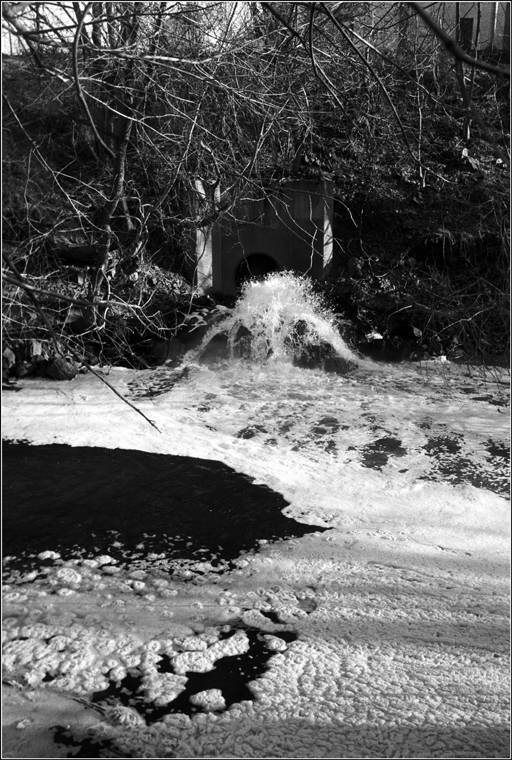waste water

RWSA outlet into Moores Creek, currently running at approximately nine million gallons per day
Missed posting yesterday, was busy assembling materials for the Rivanna Water and Sewer Authority board members. They received an excellent technical report from staff regarding the "Compost shed".
A contingent from the Woolen Mills neighborhood spoke before the Board relating the "quality of life effects" imposed by living near the steaming pile, an aspect the technical report didn't specifically address.
Note! Brian Wheeler has posted RWSA audio on his website Charlottesville Tomorrow
*************************************************
In 2003, then Mayor of Charlottesville, Mr. Maurice Cox, challenged city leaders and the Woolen Mills Neighborhood, he said:
I think it is long overdue for the Woolen Mills that they have a clear signal of where their neighborhood is going, and (that it) not be done in this piecemeal fashion.
So I guess my hope would be that out of this process, given the talent that they have in their neighborhood, that they get together and decide that proactively:
'we are going to tell you what the future of our neighborhood is going to be,'
and it is not going to continue to be an erosion of the things that they have come to feel anchor their neighborhood, that?s the residential use and some of the mixed use strategies that they have."
-Maurice Cox April 2003
I personally long for the time when businessmen built their residences next to their places of business, when they were members of a neighborhood, sharing the positive and negative effects their endeavors had on the quality of life in the area they called home.
Such was the case 100 years ago when Henry Clay Marchant lived on hill at the intersection of Moores Creek and the Rivanna River. He was the directing force of the Charlottesville Woolen Mills and his house overlooked his place of business.
The neighborhood takes its name from Marchant?s enterprise and as the business was the seed around which a neighborhood coalesced, the Woolen Mills is often considered by people who don?t know better as an ?industrial? neighborhood.
The Woolen Mills is a residential neighborhood, a Mill Village whose residents historically walked to work. Marchant?s industrialism fit well with the arboreal garden at the base of Monticello Mountain.
The industrial park that lines Broadway Street between RWSA and the Woolen Mills neighborhood was, in the time of the Mill?s operation, a recreational park. My ninety-seven year old neighbor, Lola Knight, remembers watching baseball games there. Sixty-nine year old Jean Strauss remembers playing shuffleboard in the park in the mid 1940?s.
One questions the wisdom of the City and County zoning that has located some of the heaviest industry in this region at the foot of Monticello Mountain, in the view-shed of the crown jewel of Central Virginia tourism.
The Woolen Mills neighborhood shares its south-eastern boundary with Albemarle County. Living on an inter-jurisdictional border is a dangerous affair. RWSA?s county Supervisor is Mr. Lindsey Dorrier. Mr. Dorrier?s most distant constituents are the residents of the Marchant house. Does Mr. Dorrier feel and smell their pain?
Visitors to my house in the Woolen Mills neighborhood wonder why I don?t ask my City Councilor to address the smell issue. Indeed, we, as a neighborhood, have been asking the City Council for relief from the corrosive effects we bear from the industry to our South. We have been asking for relief from the cut-through traffic and smells at least since I moved to the neighborhood in 1987.
In 1918 the Woolen Mill bought its first internal combustion vehicle.
In May, of 2005, during a 24 hour period 14 septic-tank pumping trucks short-cut through the Woolen Mills neighborhood accessing the place where they dump their loads. In the same twenty four hour period thirty-two vehicles emblazoned with the RWSA logo made their way through our residential streets. I was busy counting the traffic that day, I failed to note whether the air smelled of ?composting bio-solids.?
In the summer of 1916 the City?s main sewer pipe, a straight pipe running from the City of Charlottesville to the Rivanna, broke...
"Foul odors wafted across the mill village from the leak. The stench ended only with the arrival of the coldest winter in twenty years."
-Andy Meyers ?The Charlottesville Woolen Mills:
Working Life, Wartime, and the Walkout of 1918?
Working Life, Wartime, and the Walkout of 1918?
The leak was referred to in the Woolen Mills Board Minutes taken during the summer of 1917 a year later. Apparently the City was in no hurry to repair the failed pipe.
In my opinion, the odor we currently deal with comes close to meeting the definition of a public nuisance, described in state law:
"as an act that is injurious to health, indecent or offensive to the senses and that interferes with the comfortable enjoyment of life or property."
In 1916-1917 the City responded slowly to complaints from the Woolen Mills neighborhood regarding odor. We hadn?t been annexed then. We were Woolies, Lintheads and Albemarle County Residents to boot.
Show us that times have changed. Give us action to address the smell issue in the current year. Fast track enclosing the compost shed. Transform this mother of all outhouses from a source of community pain to a source of regional pride.
Labels: environment, government, neighborhood, riverine

1 Comments:
Nice Effluent.
Incidentally, I've always thought that since Wollen Mills is so intimately connected into Charlottesville's history that there should be more attention given to that area. I've even wondered if the City might someday by the old Mills and make it a museaum of local history and natural river history. Wouldn't that be nifty?
Post a Comment
<< Home